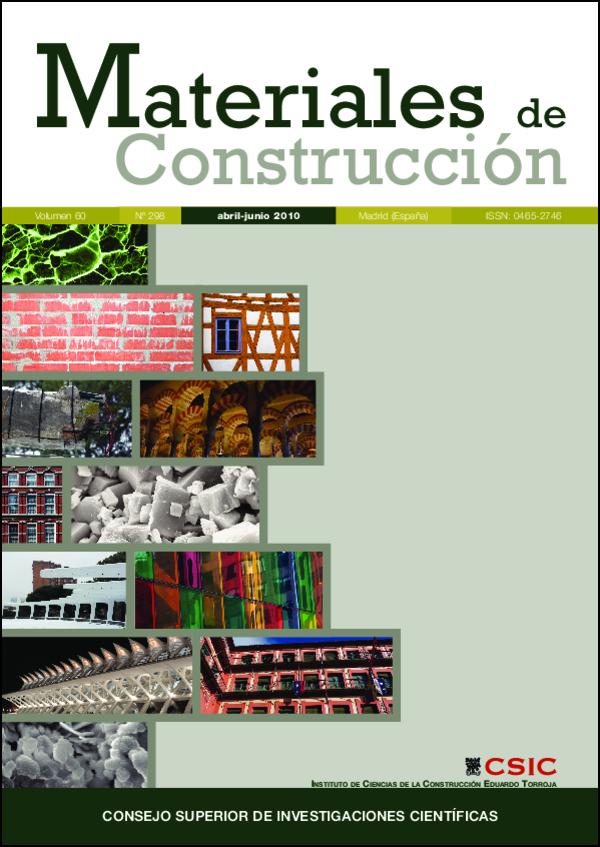Metakaolin sand – a promising addition for Portland cement
DOI:
https://doi.org/10.3989/mc.2010.51509Keywords:
cement, mortar, metakaolin sand, pozzolanic activity, hydrationAbstract
The kaolin sand resource at the Vyšný Petrovec quarry in Slovakia comes to a total of 20 megatonnes. The metakaolin material obtained by heating kaolin sand at 650 ºC contains from 31.5 to 40% (wt) metakaolinite, as well as illite, muscovite, quartz and feldspar. The aim of this study was to verify whether this calcined sand (MK1) is a pozzolanic material and characterize the cements and mortars prepared with it. The hydration reactions taking place in the blends were assessed with conduction calorimetry, X-ray diffraction (XRD) and differential thermal analysis-thermogravimetry (DTA-TG). Blend and mortar strength development and pore structure were also evaluated. The results obtained showed that this metakaolin sand (MK-1) is a pozzolanic material apt for use as a cement addition and for making mortars.
Downloads
References
(1) Kraus, I.: “New approaches to the processing and exploitation of chosen group of silicate of raw materials in Slovakia” (in Slovak language). Proceedings of the EUROSILIKAT 2004 Conference on Innovation and Raising of Competitiveness in the Mining and Processing of Non – Metallic Raw Materials, Lucˇenec, Slovakia (2004), pp. 36-40.
(2) Kraus, I.; Uhlík, P.; Dubíková, M.; Manfredini, T.; Pavlíková, J.; Sˇucha, V.; Hanúsková, M.; Honty, M.: “Mineralogical, chemical and technological characterization of kaolin sands”. Proceedings of the EUROCLAY International Conference (Book of Abstracts), Modena, Italy, 2003, pp. 160-161.
(3) Krajcˇi, L´.; Janotka, I.; Kraus, I.; Jamnicky´, P.: “Burnt kaolin sand as pozzolanic material for cement hydration”. CERAMICS – Silikáty, vol. 51, nº 4 (2007), pp. 217-224.
(4) Janotka, I.; Krajcˇi, L´.; Kuliffayová, M.; Kraus, I.: “Metakaolin sand a prospective substitute for Portland cement”. Proceedings of the 4th Mid-European Clay Conference MECC 2008, Zakopane, Poland, September 2008. Abstract is published in Polish Mineralogia – Special Papers, vol. 33 (2008), p. 72.
(5) Badiogiannis, E.; Papadakis, V. G.; Chaniotakis, E.; Tsivilis, S.: “Metakaolin as a main cement constituent. Exploitation of poor Greek kaolins”. Cement and Concrete Composites, vol. 27, nº 2 (2005), pp. 197-203. doi:10.1016/j.cemconcomp.2004.02.007
(6) Frías, M.; Cabrera, J.: “Pore size distribution and degree of hydration of metakaolin – cement pastes”. Cem. Concr. Res., vol. 30, nº 4 (2004), pp. 561-569.
(7) Frías, M.; Sánchez de Rojas, M. I.: “Influence of metastable hydrated phases on the pore size distribution and degree of hydration of MK – blended cements cured at 60 °C”. Cem. Concr. Res., vol. 35, nº 7 (2005), pp. 1292-1298.
(8) Torres, J.; Mejía de Gutiérrez, R.; Puertas, F.: “Effect of kaolin treatment temperature on mortar chloride permeability”. Mater. Construcc., vol. 57, nº 285 (2007), pp. 61-69.
(9) Frías, M.; Sánchez de Rojas, M. I.; Rodríguez, O.; García Jiménez, R.; Vigil de la Villa, R.: “Characterization of calcined paper sludge as an environmentally friendly source of metakaolin for manufacture of cementitious materials”. Advances in Cement Research, vol. 20, nº 1 (2008), pp. 23-30. doi:10.1680/adcr.2008.20.1.23
(10) Vegas, I.; Frías, M.; Urreta, J.; San José, C. T.: “Obtaining a pozzolanic addition from the controlled calcination of paper mill sludge. Performance in cement matrices”. Mater. Construcc., vol. 56, nº 283 (2006), pp. 49-60.
(11) Rodríguez, O.: “Valorizacion de un residuo industrial procedente de la industria papelera como material puzolánico”, tesis doctoral 2008, Universidad Autónoma de Madrid.
(12) Frías, M.; Sánchez de Rojas, M. I.; Cabrera, J.: “The effect that the pozzolanic reaction of metakaolin has on the heat evolution in metakaolin - cement mortars”. Cem. Concr. Res., vol. 30, nº 2 (2000), pp. 209-216. doi:10.1016/S0008-8846(99)00231-8
(13) Bágel’, L´.; Zivica, V.: “Relationship between pore structure and permeability of hardened cement mortars”. Cement and Concrete Research, vol. 27, nº 8 (1977), pp. 1225-1235.
(14) Janotka, I.; Bágel’, L´.: “Pore structures, permeabilities and compressive strengths of concrete at temperatures up to 800 ºC”. ACI Materials Journal, vol. 99, nº 2 (2002), pp. 196-200.
(15) Mojumdar, S. C.; Sain, M.; Prasad, R. C.; Sun, L.; Venart, J. E. S.: “Selected thermoanalytical methods and their applications from medicine to construction: Part 1”. Journal of Thermal Analysis and Calorimetry, vol. 90, nº 3 (2007), pp. 653-662. doi:10.1007/s10973-007-8518-5
Downloads
Published
How to Cite
Issue
Section
License
Copyright (c) 2010 Consejo Superior de Investigaciones Científicas (CSIC)

This work is licensed under a Creative Commons Attribution 4.0 International License.
© CSIC. Manuscripts published in both the print and online versions of this journal are the property of the Consejo Superior de Investigaciones Científicas, and quoting this source is a requirement for any partial or full reproduction.
All contents of this electronic edition, except where otherwise noted, are distributed under a Creative Commons Attribution 4.0 International (CC BY 4.0) licence. You may read the basic information and the legal text of the licence. The indication of the CC BY 4.0 licence must be expressly stated in this way when necessary.
Self-archiving in repositories, personal webpages or similar, of any version other than the final version of the work produced by the publisher, is not allowed.
















